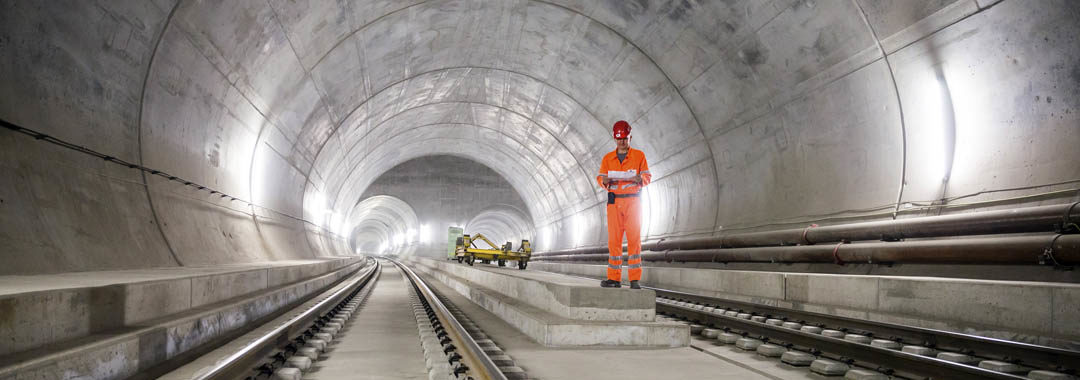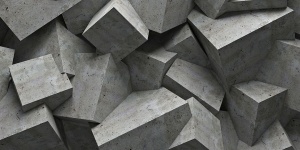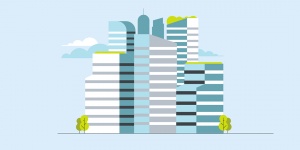The Gotthard Base Tunnel is an extraordinary feat of modern engineering. Running for 57km under the Swiss Alps, it is not only the world's longest railway tunnel but also the deepest. Its designers needed to keep the tracks as level as possible, so they drilled 2.3km below the mountain to achieve this.
Consisting of two single-track tubes, along with associated passenger infrastructure, shafts, and safety and ventilation tunnels, the entire tunnel system has a total length of almost 152km, and its construction required the extraction of 28.2 million tonnes of rock.
This record-breaking infrastructure is also one of Europe's largest environmental projects. Its impressive achievements in construction, logistics and sustainability were made possible, in part, thanks to an innovative use of strong, versatile, high-tech cement.
Opened in 2016, the tunnel provides a high-speed rail link between the Swiss cities of Erstfield in the north and Bodio in the south, or more significantly, cutting the journey time between Milan and Zurich by an hour.
Cutting environmental costs
The Gotthard Base Tunnel is the cornerstone of the Alpine Initiative. Adopted by Switzerland in 1994, this project aims to protect the country's natural landscape by reducing damage caused by road traffic. By switching freight and passenger traffic from road to rail, the tunnel is making a significant impact on reducing disruptive and polluting heavy goods traffic in the Alps. In February the tunnel project was awarded the 2018 European Railway Award for its work in shifting goods transport from road to rail. It is also expected to save around €120m each year in environmental costs.

Workers walk near a support train inside the east section of the Gotthard Base Tunnel. (Photo by Philipp Schmidli/Bloomberg via Getty Images)
In order to meet its environmental aspirations, this ambitious project faced an array of technical challenges – the largest of which was how to transport concrete over long distances, under high temperatures, without it setting.
Add to this, a tight time schedule, and the stipulation that 100% of the aggregate used must come from recycling materials excavated on site, some innovative thinking was needed.
Creating a sustainable cement solution
The solution came in the form of a new specialist cement formula which enabled a high-tech ready-mix concrete (RMX). With an increased setting time of 11, rather than six hours, this doubled the distance that the concrete could be transported while remaining workable. By extending the setting time, the concrete could be moved into the tunnel quickly and efficiently via rail. It also meant that it was not necessary to build an additional concrete plant, further reducing environmental impact.
Key to ensuring that the material was sustainable was the use of recycled aggregate – with the tunnel team recycling more than one third of 28.2 million tonnes of excavated rock during the manufacture of the concrete.
“This project demonstrates how using innovative, sustainable and adaptable concrete and cement can tackle environmental challenges.” Fabio Pellegrini, Tunnel International Manager, LafargeHolcim
Fabio Pellegrini, Tunnel International Manager at LafargeHolcim, which developed the RMX, explains: "This recycling approach, consisting of using local excavated material with different geological characteristics in a new concrete, was made possible thanks to a special and innovative cement formula that enabled us to provide a durable, robust and above all resistant concrete for the tunnel."
The high-tech concrete is also extremely durable, and is expected to last the 100-year life span of the project.

Workers stand on a scissor lift as they fix cable support trays to the access tunnel wall inside the Gotthard Base Tunnel. (Photo by Philipp Schmidli/Bloomberg via Getty Images)
Excavation management
With such a challenging project, the correct management of the excavation material was essential, explains Pellegrini.
By viewing the excavated rock as a valuable raw material, rather than just waste to be dumped, the team was able to achieve sustainable tunnelling with optimal use of resources and minimal impact on the environment. The landfilling of excavated materials was unnecessary and there was no need to extract natural resources from quarries.
"This recycling approach…..was made possible thanks to a special and innovative cement formula that enabled us to provide a durable, robust and above all resistant concrete for the tunnel." Fabio Pellegrini, Tunnel International Manager, LafargeHolcim
Greenhouse gas emissions were also reduced. For example, the excavated, recycled aggregate was carried on environmentally-friendly conveyer belts, rather than trucks, to the on-site mixing plant.
"This project demonstrates how using innovative, sustainable and adaptable concrete and cement can tackle environmental challenges," says Pellegrini.

Workers construct the tunnel entrance. (Photo by Nicola Demaldi)
Thanks to the use of high-tech cement and concrete innovation, the Gotthard Base Tunnel – one of the world's most ambitious infrastructure projects – has successfully met its environmental aims, and is expected to provide a resilient solution for generations to come.




